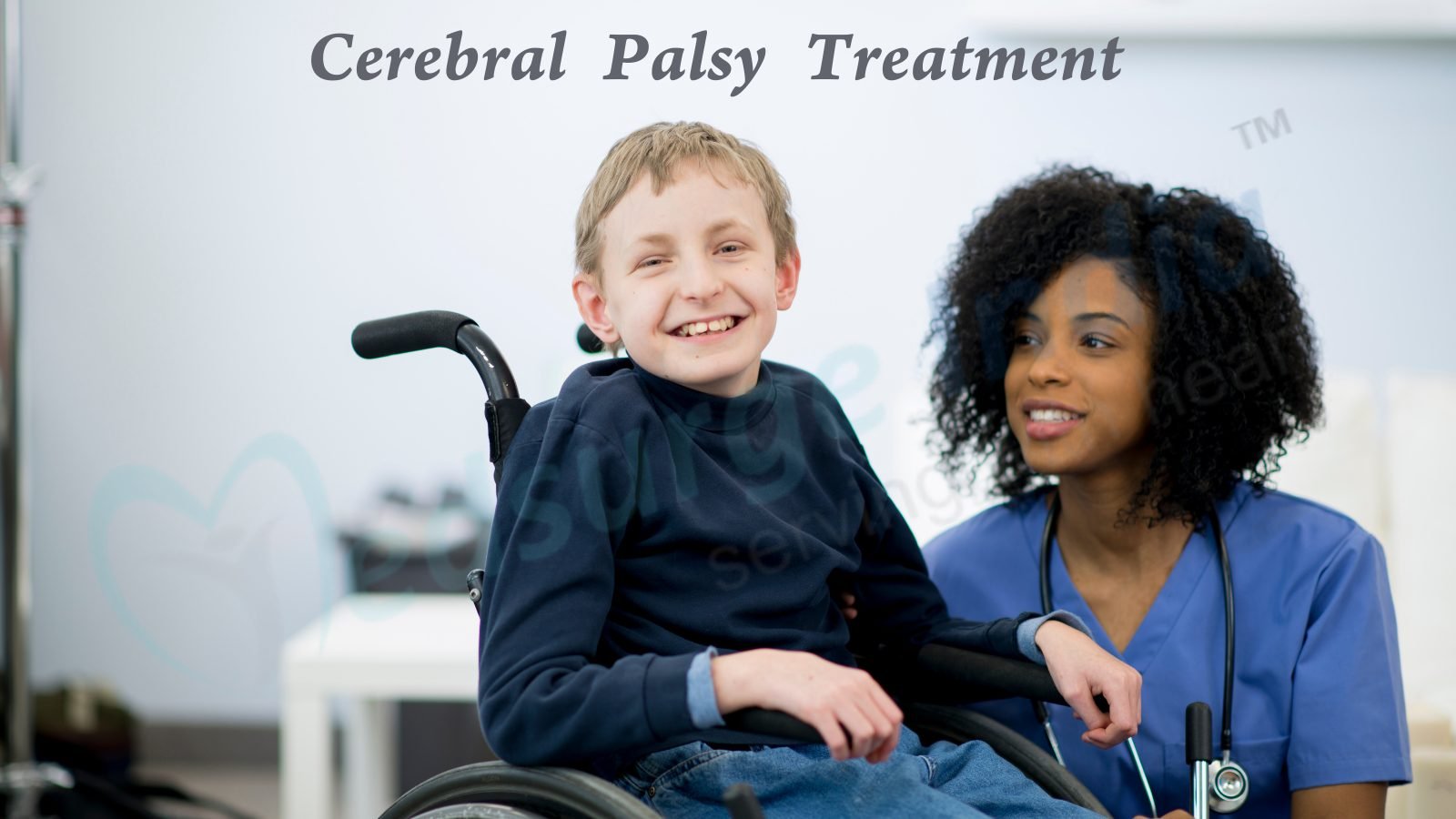Cerebral Palsy Treatment Cost in India
Unlock Exclusive Discount : Your Gateway to Premium Healthcare with Medsurge India Health Value Card.

Unlock Exclusive Discount : Your Gateway to Premium Healthcare with Medsurge India Health Value Card.


The term “cerebral” signifies a connection to the brain. The term “palsy” refers to a condition in which the body’s movement is restricted. Cerebral Palsy (CP) is a mobility and posture disorder that manifests in toddler or early childhood and is caused by brain injury.
The signs and symptoms of Cerebral Palsy vary from one individual to the next. A person with severe CP may require special apparatus to walk or may be unable to walk at all, necessitating lifelong care. A person with mild CP, on the other hand, may walk awkwardly but not require any extra assistance. Though the exact symptoms of CP can fluctuate during a person’s lifetime, the condition does not worsen.
Movement and posture are issues for all people with CP. Many people additionally suffer intellectual disabilities, seizures, visual, hearing, or speech issues, abnormalities in the spine such as scoliosis, or joint problems (such as contractures).
Cerebral palsy is a term used to describe a collection of non-progressive brain malformation conditions that impact a person’s movement and posture. Damage to the developing brain occurs during pregnancy or shortly after the birth of the baby, resulting in a lifelong physical problem. One of the most prevalent physical disorders in children is cerebral palsy (CP).
Limited mobility, stiffness, limb weakness, shakiness, poor coordination, and balance are some of the movement issues that children with the cerebral palsy face. Other issues that it can cause include vision, hearing, speech, learning, epilepsy, and cognitive thinking.
Cerebral palsy (CP) is classified according to the following factors:
Affected organs and parts of the body
There are several types of Cerebral Palsy, each of which affects different regions of the brain. Each type produces different types of mobility problems. The following are the several sorts of CP:
Cerebral Palsy Treatment Cost in India on average starts from USD 1200. Note that, the price mentioned is only for the treatment. Other factors will also depend on the total cost of the treatment for Cerebral Palsy Treatment in India.
Reminder: The cost and treatment options for Cerebral Palsy Treatment Cost in India may differ based on the patient’s preferences and other factors.
Several factors can also affect the cost of Cerebral Palsy Treatment in India Here are some of the factors that can affect Cerebral Palsy Treatment Cost in India:
Cerebral Palsy Treatment Cost in India offers exceptional medical services and facilities to patients who come for treatment in India also their facilities rival those of well-known healthcare centers worldwide. Accommodation, meals, and transportation expenses are also covered.
We at, Medsurge India ensure that patients will receive the most affordable Cerebral Palsy Treatment Cost in India and with the expertise of highly qualified doctors. Furthermore, a foreign patient can save up to 30-40% of the cost in India when compared to their native countries.
Early symptoms of cerebral palsy can be seen in children as young as one year old. Sucking/feeding challenges, neck control problems, sitting without support problems, rolling, crawling, grasping problems, and other basic motor functions problems are frequently the first signs of cerebral palsy.
When the Youngster Is Under the Age of Six Months:
When the Youngster Is Older Than Six Months:
the Following Are Some of the Most Common Physical Signs of Cerebral Palsy:
Brain damage can result from an aberration that happens during brain development during the fetal stage (pregnancy), during birth, or after birth. Cerebral palsy can come from a variety of different sources of brain injury.
In the vast majority of cases, the actual causes of Cerebral Palsy are unknown. The following are some of the possible causes:
If your family doctor or pediatrician suspects your kid has cerebral palsy, he or she will assess your child's signs and symptoms, track his or her growth and development, review his or her medical history, and perform a physical examination. Your doctor may recommend you to a pediatric neurologist, pediatric physical medicine and rehabilitation specialist, or a child developmental specialist who specializes in treating children with brain and nervous system disorders.
In order to make a diagnosis of cerebral palsy, your doctor may prescribe a series of tests to rule out the possible reason for the disorder. The use of brain-imaging technology can reveal areas of injury or aberrant brain development. The following are examples of possible tests:
Stem cell therapy is a type of cellular therapy that falls under the umbrella of Regenerative Medicine, a futuristic discipline of medicine concerned with the process of repairing or regenerating damaged tissues in the body.
Stem cells are undifferentiated, primitive cells with the ability to transform into any other cell type with specialized activities. They are distinct in two ways: they reproduce indefinitely to form new cells (self-renewal) and they develop into specialized cells such as muscle cells, heart cells, brain cells, and others.
Stem cell treatment takes advantage of stem cells' unique properties to treat or prevent medical diseases from worsening. There are three basic types of stem cells that can be employed in research:
ESCs are cells identified in a 5-7-day-old developing embryo. These stem cells are pluripotent, which means they can transform into any other cell type in the human body.
These cells can be found in every human's tissue. They have progressed through the embryonic stage. These are multipotent cells that can only differentiate into a small number of distinct types of cells. Adult stem cells have the ability to regenerate and fix damaged tissues in the body. They can be extracted from particular bones, such as the bone marrow of the hip bone.
After a baby is born, the umbilical cord is discarded, and stem cells are extracted from it. After delivery, mothers can donate the cord, which is then kept in cord blood banks for future need.
For transplantation, autologous stem cells are obtained from the patient's own body. The advantages of this procedure are that it eliminates the possibility of rejection by using own cells, and it reduces the risk of adverse effects.
The stem cells are taken from a donor and then put into the patient. Before harvesting the cells for transplant, the donor must be screened for genetic compatibility. For this type of transplant, umbilical cord stem cells can also be employed.
Treatment aims to alleviate limitations and avoid problems. Assistive devices, drugs, and surgery are among options for treatment of Cerebral Palsy
Your doctor may also recommend botulinum toxin type A (Botox) injections or intrathecal baclofen therapy, in which the medicine is given through an implanted pump.
Other approaches for Cerebry Palsy treatment include:
Despite the fact that stem cell therapy is being investigated as a possible treatment for CP, research is still in its early phases.
A: Not exactly. Cerebral palsy may be caused by a genetic defect, but it does not pass down normally from generation to generation. However, several events that occur throughout the delivery process can have a significant impact on a child's chances of developing cerebral palsy. As a result, parents must exercise extreme caution during pregnancy to avoid any such complications.
A: The traditional treatment is extremely intrusive and focuses solely on suppressing symptoms with the use of steroids and other drugs. It also does not provide long-term relief from the symptoms of cerebral palsy. It has adverse effects that are as obvious as the favorable results, thus it isn't a complete approach to treating cerebral palsy patients. Because stem cell therapy tries to repair the damage done to the brain, the effects are better and faster. Aside from that, the treatment has no negative effects on the patient.
A: Yes. Cerebral palsy is more common in premature and low birth weight babies because they are more vulnerable to birth injuries and brain damage. Modern medical research has significantly aided in preventing such damage, but such babies still fall into the high-risk category.
A: Yes, a mother's medical situation can have a significant impact on her kid, and women with mental retardation, seizure problem, or thyroid dysfunction are categorized as high-risk.
A: Cerebral Palsy treatment does not follow the same pattern for all children. Greater improvement is shown after stem cell therapy for cerebral palsy when it is followed by subsequent rehabilitation. After a complete medical evaluation, this may incorporate both traditional and innovative techniques that are individualized for each child. Physical therapy, occupational therapy, speech therapy, aquatic therapy, art-based therapies, and group/motivational classes are some of the therapies that are used after stem cell treatment.
By using our site, you agree to our Terms and Conditions, Privacy Policy and Refund Policy. Medsurgeindia does not provide medical advice, diagnosis, or treatment. The information provided on this site is designed to support, not replace, the relationship that exists between a patient/site visitor and his/her existing physician. We also Accept International Payments.

Copyright © 2025 NSM ONLINE SOLUTIONS PRIVATE LIMITED. All rights reserved.